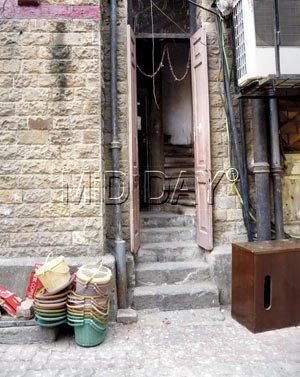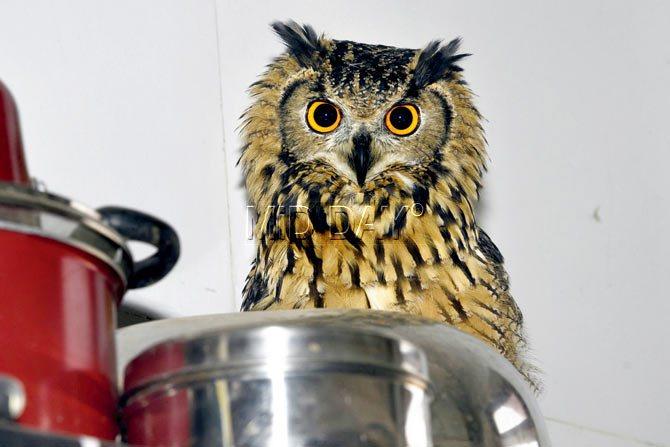Three giddy flights up Pradeep D'Souza's Fort residence is where hundreds of injured birds find succor

Vanessa helps Pradeep Du00e2u0080u0099Souza feed and treat the injured birds
Friday was a busy day for Pradeep D’Souza. The messiah of injured and sick birds was flitting from a seagull to a kite, both injured by sharp manjas slicing their wings while Makar Sankranti revellers were busy outdoing each other in the skies.

Vanessa helps Pradeep D’Souza feed and treat the injured birds
ADVERTISEMENT
The spiral staircase of Queens Mansion at Fort, that can accommodate no more than one slim person at a time, winds up to D’Souza’s terrace home where close to 400 birds find shelter on an average. Plastic baskets placed at the ground floor entrance of the ageing but grand heritage building is where volunteers and pet owners drop off their avian friends for treatment. The smell of bird poop gets stronger as you climb up to the third floor.

A kite injured by a manja
The recovering handicapped egrets, herons and kites loiter around the terrace and tanks shared by D’Souza and his neighbours, none of who seem to mind the avian presence.
This has been the 40-year-old’s life for 25 years. And, although he isn’t a trained vet, it’s around sick birds, rabbits and mice that D’Souza, his brother, sister-in-law Joanita and 16-year-old niece Vaneesa spend their days. We spot the first-year student of Sophia College hold on tightly to a seagull as her uncle dabs Betadine on its wound.

Volunteers leave birds in baskets at the entrance of D’Souza’s Fort building; Babush, who was rescued from a black magician. Pics/Atul Kamble
A small mezzanine space up another wooden ladder accessed with support from a rope holds cages with roofs that open to the sky. Once fit, the birds are free to fly away at will. Separate step-in enclosures on two extreme ends have been created for kites, owls and seagulls. The smaller cages house bats, pigeons, crows, mice, rabbits and parakeets.

“The 400 birds that we house right now include 180 kites, 16 rabbits, 15 mynahs and 40 owls. On an average, we get up to 30 injured friends every day,” says D’Souza.
His experience with The Welfare of Stray Dogs comes handy, he says. “Now, I do this full time. Every morning, I wake up at 5 am and visit Crawford Market to pick up food for the birds. They like cabbage and corn, and papaya, banana, chickoo and apples among fruits.” The vendors know him by name and that he won’t accept stale or discarded wares just because it’s not for human consumption.
The family spends close to Rs 30,000 every month, while excess cost is bourn by non-profit Sparsh Foundation. “A Jain mandal has sponsored the cages,” says D’Souza throwing a smile at a kite. “We got him yesterday. For the last fortnight, we have been mainly getting birds injured by the manja,” he says.
The white gull by its side has a muscle tear. “Its wing will eventually dry up and fall off. It will be left handicapped,” Vanessa laments, before inviting us for a cup of tea. Black button eyes with bright yellow rims peep out from behind a cupboard. “That’s Babush,” Joanita says about the jungle owl. “We got him from an NGO in Vashi four months ago. When he came to us, all his black features had been plucked. He was used for black magic. He’s our lucky charm now. These birds give us more love than humans.”
Animal lovers, pet parents and volunteers across south Mumbai know they have the family to fall back on if they encounter an injured bird. “We have two pick-up points, at Mahalaxmi and CP Tank,” he says. I leave at 7.30 pm every evening and return at about 10 pm with new entrants. I have a custom-made cotton lined case with holes to bring them home,” says D’Souza, pointing to a military green bag. “This ensures that they do not suffer jerks during the ride. All the cops and traffic policemen along the way know me. If I am in a rush, they allow me to take the bike on JJ Flyover, and some ignore my missing helmet because they know I may be saving a life.”
D’Souza says if it’s not the manja, speeding cars (that birds ram into) and viruses are top culprits. “When flying birds bang into cars, their ribs get fractured. Change of season can also leave them ill,” he shares.
We realise we haven’t asked him about his education and training. “Where did you learn all this?”
“Pata nahin, exactly,” he says earnestly.
 Subscribe today by clicking the link and stay updated with the latest news!" Click here!
Subscribe today by clicking the link and stay updated with the latest news!" Click here!







